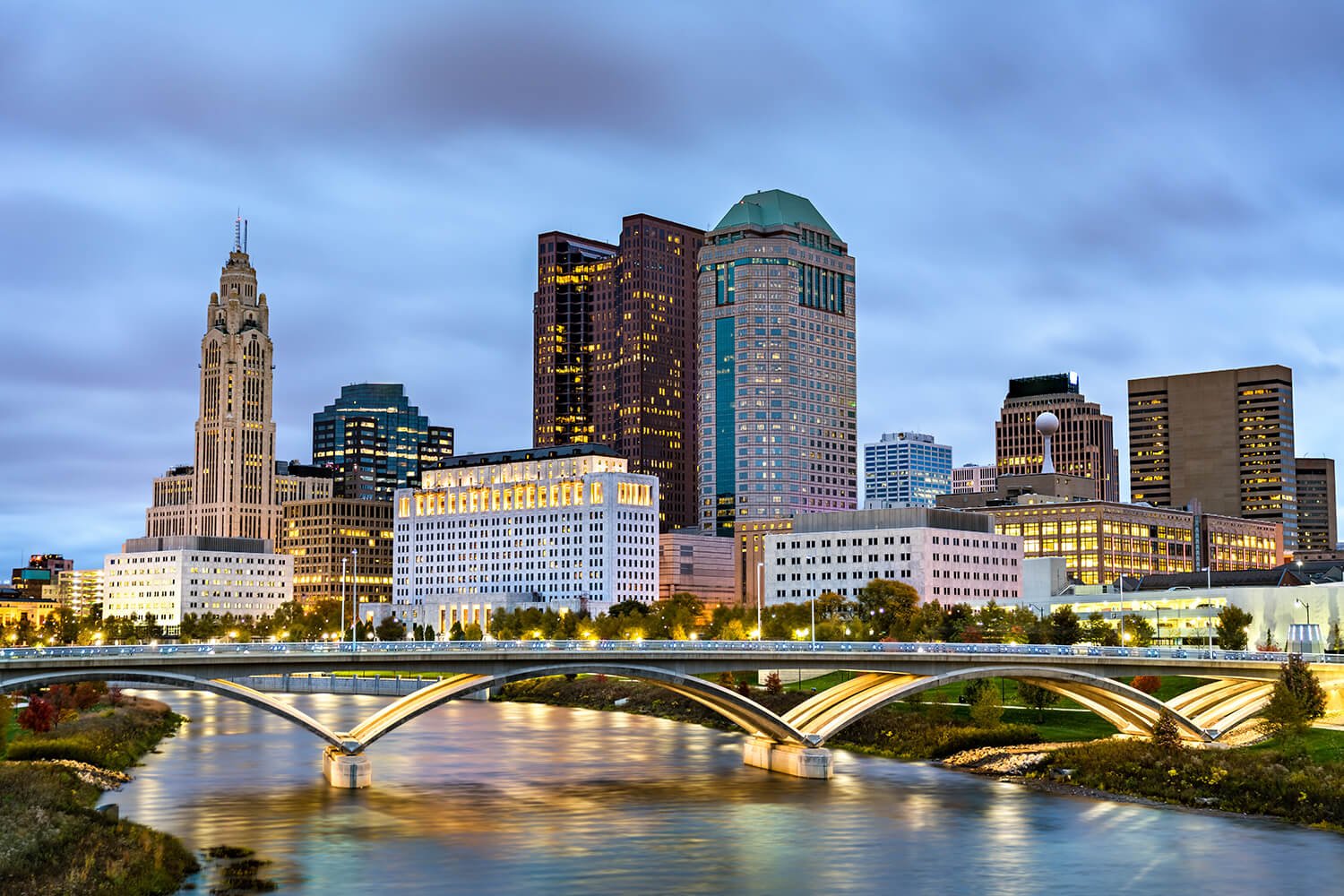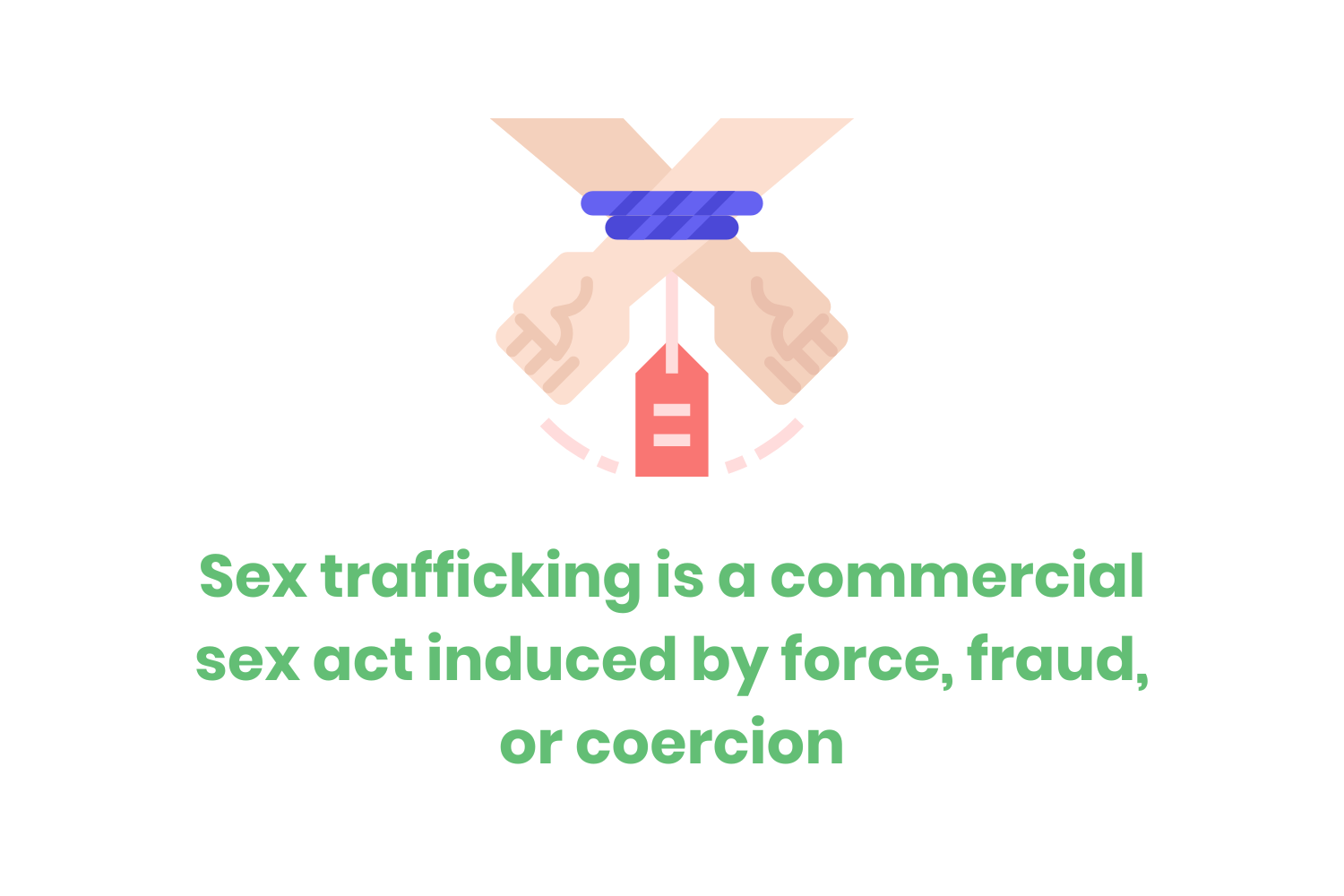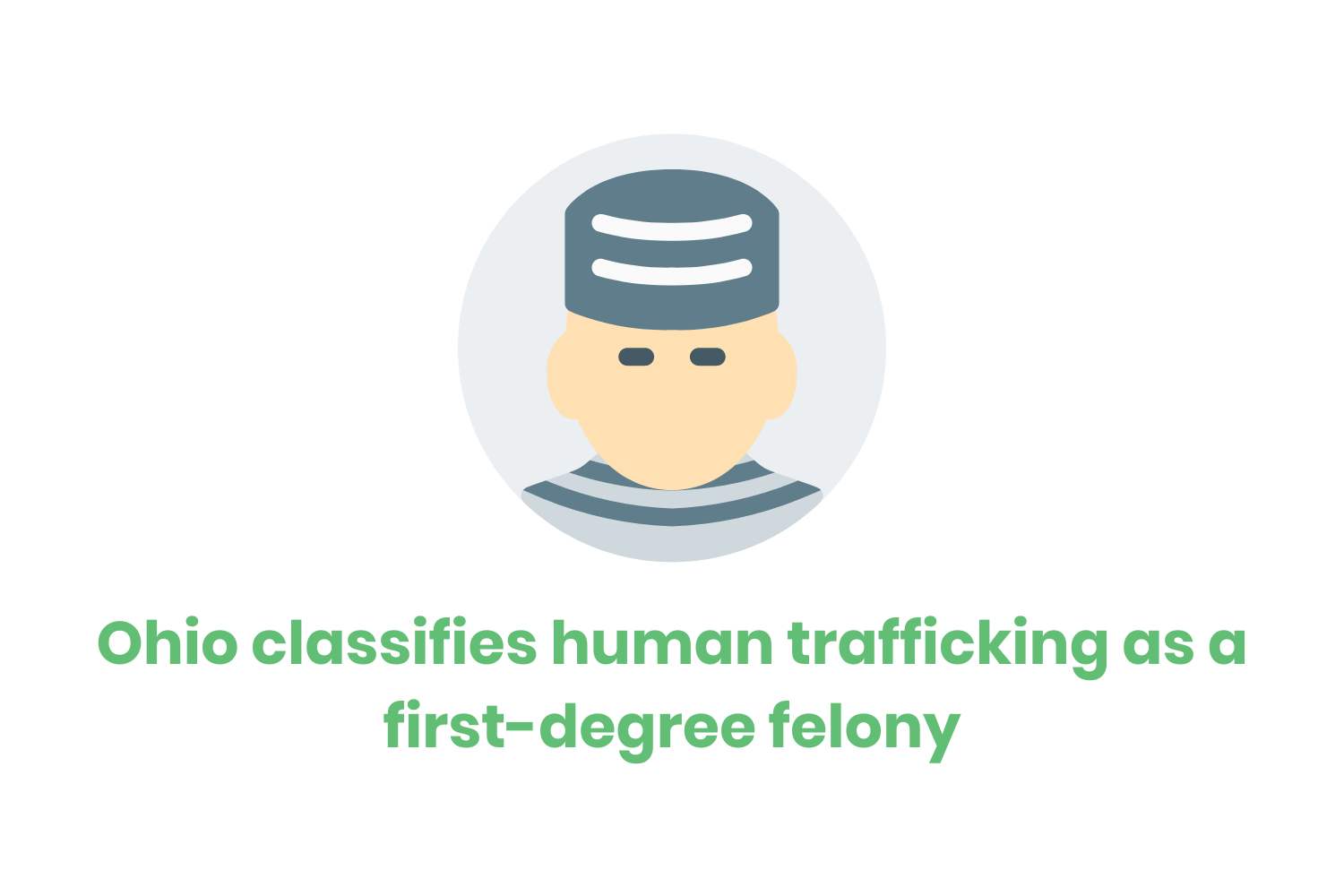Human trafficking in Ohio is not a pleasant topic, to say the least. But in order to stop it from happening, we need to discuss it. That way, the general public becomes aware of the indicators of trafficking so that they can help stop it.
Since 2007, citizens of Ohio reported 2,813 cases of human trafficking to the National Human Trafficking Hotline (NHTH). In 2020, the NHTH received 310 human trafficking-related reports from Ohio. Ohio produced 1,087 contacts as the pandemic rampaged across the world.
After reading those awful statistics, the situation may seem hopeless. The human trafficking situation in Ohio is one of the worst out of all 50 states and Washington DC.
Luckily, the buckeye state is taking steps to save victims from their situations and imprison perpetrators.
Between the various federal legislation and Ohio laws, police officers have a better chance of removing victims trafficked through the state from their enslavement. The Ohio judicial system continually improves itself so that it can prosecute human traffickers and suspected buyers of trafficking services.
If the public becomes more aware of the signs, legislation, and local mitigation efforts, they can inform the police more effectively. In turn, human trafficking in Ohio will diminish and more victims will find their freedom.
Table of Contents
Federal Laws
Trafficking Victims Protection Act of 2000
The federal government passed the first comprehensive set of laws to address human trafficking in 2000. The Trafficking Victims Protection Act (TVPA) focuses on the international components of human trafficking.
According to TVPA, sex trafficking is a commercial sex act induced by force, fraud, or coercion. Sex trafficking is also any situation in which the person performing the act is younger than the age of 18.
The federal government defines labor trafficking as the recruitment, harboring, transportation, provision, or obtaining of a person for the purpose of involuntary servitude, peonage, debt bondage, or slavery. Victims find themselves performing labor services due to force, fraud, or coercion.
Anyone found guilty of perpetrating sex trafficking or labor trafficking can face prosecution from the federal government. Other preventative efforts include public awareness overseas programs and State Department-led monitoring and sanction programs. The federal government also created victim protection programs through T-Visa and services for foreign national victims.
Preventing Sex Trafficking and Strengthening Families Act of 2015
In 2015, the federal government created a comprehensive law to address the accountability and reporting of runaway and missing children in foster care. The Preventing Sex Trafficking and Strengthening Families Act requires all states to review their administrative codes to ensure compliance. As such, Ohio reviewed its Administrative Code (OAC).
Under these laws, states must report missing or abducted foster children to law enforcement.
They can also report the missing child to the National Center for Missing and Exploited Children.
These organizations need to investigate the situation. For example, investigators determine the primary factors that contributed to the child running away or their absence from care. The foster care system then uses this information when determining future placements.
After the investigation, the government needs to address the events and experiences that lead to the child becoming absent. The police need to determine whether the child was missing due to becoming a sex trafficking victim.
Ohio Human Trafficking Policies
Ohio Laws
The Ohio Revised Code Section 2905.32 addresses the illegal trafficking of people. Ohio’s legal definition of human trafficking has two parts:
No one will consciously recruit, lure, entice, harbor, isolate, transport, provide, or maintain an individual knowing that the individual will face involuntary servitude or forced engagement in sexual activity.
In order to prosecute someone using the definition above, the term “compelled” means that the victim’s will was overcome by force, fear, duress, intimidation, or fraud.
It’s important to note that the situation is different for a victim under the age of 18. If a minor becomes a victim of human trafficking, law enforcement doesn’t need to prove the perpetrator compelled the minor. The same is true for victims who have developmental disabilities.
Criminal Sanctions for Traffickers and Purchaser
Ohio classifies human trafficking as a first-degree felony. This translates to a mandatory minimum of 10 years in prison (ORC 2905.32 (E)).
Once released, anyone convicted of sex trafficking must register as a tier two sex offender. Part of this registration mandates that they cannot live within 1,000 feet of a school (ORC 2950.01 (F)(1)(g)).
Obstruction of Justice is a second-degree felony as it pertains to human trafficking cases (ORC 2921.32 (C)(6)).
Advertising any activity related to an illicit massage parlor that suggests or promises sexual activity is illegal. Such advertising is a misdemeanor offense (OCR 2927.17).
Purchasing sexual services from anyone under the age of 18 is a third-degree felony (OCR 2907.21). Depending on the age of the minor, compelling that minor to engage in sexual activity can result in different legal consequences (ORC 2907.21 (A)(1)). If the minor is under the age of 16, anyone convicted of this faces a penalty of a first-degree felony. Similarly, if a minor is either 16 or 17 years of age, the penalty is a second-degree felony.
Ohio legislation considers the purchasing of sexual services from anyone ages 18 and over to be engaging in prostitution. Such activities are first-degree misdemeanors in Ohio (OCR 2907.231). Promoting prostitution is also a felony offense.
Depending on how many times the courts find an individual guilty of prostituting an adult, the felony offense can change.
First offense: fourth-degree felony
Second offense: third-degree felony (OCR 2907.22)
Third offense or more offenses: second-degree felony.
Promoting the prostitution of a minor is slightly different. According to Ohio laws, this would lead to a third-degree felony. (ORC 2907.22 (B)(2)(a))
It’s important to outline that sex trafficking can include prostitution. However, not all instances of prostitution fall in the realm of sex trafficking. Unlike prostitution, sex trafficking involves a third-party beneficiary. This means that someone besides the victim and any other person involved in the sex act benefits from the situation.
Examples of a third party include pimps, a significant other, a friend, or a relative.
Ongoing Reporting
Ending sex trafficking in Ohio is a priority of the government from all parties at all levels of politics.
After becoming Ohio’s Attorney General in 2019, Dave Yost created the Human Trafficking Initiative (HTI). HTI’s mission is to end labor and sex trafficking statewide through…
Building awareness
Empowering Ohioans to join local initiatives
Helping victims
Convicting traffickers and buyers
To achieve those objectives, HTI works with law enforcement agencies on all levels, nonprofit organizations, and local anti-trafficking coalitions.
Many Ohio laws help with the HTI’s initiatives. The laws require local law enforcement agencies to forward any information from their human trafficking investigations to the Bureau of Criminal Investigation (BCI). In turn, this helps build more awareness about Ohio traffickers, victims, and buyers and can aid the public in identifying future human trafficking situations.
Ohio Suspected Human Traffickers
In 2021, data from police investigations showed that Ohio was able to identify 92 human trafficking suspects. This led to 50 arrests during the year and 14 successful criminal convictions. Many investigations are ongoing, either with the police agencies or within the Ohio courts.
It’s important to note that investigations positively identified 92 human trafficking suspects. However, law enforcement agencies identified a total of 119 potential human traffickers, all of whom were positively identified as sex traffickers.
What do traffickers in Ohio look like?
The vast majority of traffickers in Ohio are male. Only about one-sixth of the 119 suspected human traffickers are female. In terms of age, around half of suspected traffickers are in their thirties. The other half are mostly in their twenties, forties, and fifties. When it comes to race, over half are African American. Another third of them are white.
Ohio Suspected Buyers
Police identified 33 suspected buyers, also known as “johns”, connected to human trafficking in 2021. They were all identified as consumers of sex trafficking. Investigations did not connect any of these people to labor trafficking that year.
What does a buyer of human trafficking-related services look like?
Every single john of sex trafficking identified in 2021 was male. About half of them were in their thirties and another half were in their forties and fifties. The vast majority of them were white with an additional five suspects classified as African American.
The police didn’t arrest all of the 33 suspected human trafficking consumers. Many are still under investigation and may face arrest in the next few years as investigations continue.
Ohio Victims
The investigations conducted in 2021 led to the identification of 138 potential human trafficking victims. 133 of these potential victims were victims of sex trafficking and the other 5 were both sex and labor trafficking.
Cases classified as both sex and labor trafficking often involve sexual acts conducted in a commercial setting. This could include victims forced to perform in adult video content or forced to work as exotic dancers. In both of these examples, the victim finds themselves in a situation where someone pays for the sexual services they perform against their will.
Before I detail the victim demographics identified in Ohio last year, I must mention these demographics may be different from national averages.
Nationwide, labor trafficking victims are more likely to be Hispanic or Asian. Sex trafficking victims are more likely to be White (26%) or African American (40%).
Ohio demographics are also different compared to global averages. Victims of sex trafficking only constitute 19% of the estimated victims around the world, yet generate two-thirds of global profits. Additionally, women and girls constitute 71% of human trafficking victims around the world. Around 25% of human trafficking victims globally are below the age of 18.
Ohio is a bit different. Over 95% of victims identified in 2021 are female. The majority of them are in their 20s, 30s, and 40s. When it comes to race, 86 of the 138 identified victims were white and another 36 were African American.
Anti-Human Trafficking Coalitions
In 2020, 17% of human trafficking-related communication coming to the National Human Trafficking Hotline comes from community members. These communication efforts came from a variety of signals, including phone calls, SMS, online, emails, and webchats.
Luckily, Ohio ranked 6th for the highest signal volume of all 50 states and Washington DC in 2020. If more community members became active in their local coalitions, we could drastically increase the number of signals received and the number of victims removed from the trafficking situation.
By becoming active in your local anti-trafficking response efforts, you can positively impact the lives of those around you.
Below are all of the coalitions in Ohio along with their contact information.
Abolition Ohio - Clark, Greene, Montgomery, and Preble Counties
E-mail: abolition.ohio@gmail.com
Phone number: (937) 229-4326
Appalachian Voices Unite - Scioto County
E-mail: halea.hatten@portsmouthoh.org
Phone number: (740) 354-8949
24-hour hotline: (513) 800-1863
Crisis number: (740) 354-1010
Belmont County Human Trafficking Coalition - Belmont County
E-mail: patriciaa@bhmboard.org
Phone number: (740) 695-9998
Central Ohio Reach and Restore Coalition - Champaign, Crawford, Fairfield, Fayette, Franklin, Knox, Logan, Richland, Licking, Madison, Marion, Morrow, and Union Counties
E-mail: mhannan@use.salvationarmy.org
Phone number: (614) 437-2149
Office, The Salvation Army
Collaborative to End Human Trafficking (Cleveland) - Cuyahoga County
E-mail: info@collabtoendht.org
Phone number: (440) 872-6500
Coshocton County Human Trafficking Coalition - Coshocton County
E-mail: firststepcosh@sbcglobal.net
Phone number: (740) 622-8504
Office, First Step Family Violence Intervention Services, Inc.
Delaware County Against Human Trafficking Coalition - Delaware County
E-mail: burban@uwaydelaware.org
Phone number: (614) 436-UWAY (8929)
Office, United Way of Delaware County
End Slavery Cincinnati - Adams, Brown, Butler, Clermont, Clinton, Hamilton, Highland, and Warren Counties
E-mails:
erin.meyer@use.salvationarmy.org
Brianna.Combs@use.salvationarmy.org
Phone number: (513) 762-5690
Office, The Salvation Army
24-hour hotline: (513) 800-1863
Erie County Human Trafficking Coalition - Erie County
E-mails:
tracygm@bgsu.edu
lwilken@bgsu.edu
Phone numbers:
Tracy: (419) 372-0692
Lara: (419) 366-0614
Gallia County CRP Human Trafficking Collaborative - Pickaway County
E-mail: galliacprhumantrafficking@gmail.com
Human Trafficking Collaborative of Lorain County - Lorain County
E-mail: regenerate07@yahoo.com
Phone number: (440) 458-1184
Lake County Collaborative to End Human Trafficking - Lake County
E-mail: c.kinkoph@csuohio.edu
Phone number: (440) 339-4494
Lucas County Human Trafficking Coalition - Lucas, Ottawa, Sandusky, Seneca, and Wood Counties
E-mails:
amy.lagesse@utoledo.edu
jmeyer@lucasdd.org
Phone number: (419) 530-4185
Office, University of Toledo
Medina County Coalition Against Human Trafficking - Medina County
E-mail: eewing@alternativepaths.org
Phone number: (330) 764-8891 ext. 214
Office, Children’s Center of Medina County
Mideast Ohio Rescue and Restore Coalition - Muskingum, Perry, and Washington Counties
E-mails:
jlong2526@hotmail.com
christinec@fmchealth.org
Phone numbers:
Jannet: 740-586-5861
Christine: 740-808-4807
Northwest Ohio Rescue and Restore Coalition - Allen, Auglaize, Defiance, Fulton, Hardin, Henry, Mercer, Paulding, Putnam, Van Wert, Williams, and Wyandot Counties
E-mail: breyes@crimevictimservices.org
Phone number: (567) 940-8264
Office, Crime Victim Services
Northwest Ohio Rescue and Restore Coalition: Hancock County Chapter - Hancock County
E-mail: tippie@findlay.edu
Phone number: (419) 222-8666
Office, Crime Victim Services
Northwest Ohio Rescue and Restore Coalition: Tri-County Chapter - Darke, Shelby, and Miami Counties
E-mail: rloaiza@crimevictimservices.org
Phone number: (419) 222-8666
Office, Crime Victim Services
Partners Against Trafficking of Humans, Stark County (PATHS) - Stark County
E-mail: jnknight@starkcountyohio.gov
Phone numbers: (330) 451-7888
Pickaway Human Trafficking Coalition - Pickaway County
E-mail: pickawayhumantrafficking@gmail.com
Phone numbers: (740) 409-0219
Pike County Coalition to End Human Trafficking - Pike County
E-mail: partnershiprhiannon@yahoo.com
Phone number: (740) 947-1611
Southeastern Ohio Human Trafficking Coalition
E-mail: havenofhope@firewireinternet.com
Phone number: (740) 439-7233
Office, Haven of Hope
24-Hour Hotline: (740) 439-4455
Guernsey County Sheriff’s Office
Summit County Collaborative Against Human Trafficking - Summit County
E-mail: SCCAHT.chair@gmail.com
Phone number: 234-200-6659
ORRIN Collaborative of Trumbull and Mahoning County - Mahoning and Trumbull County
E-mail: staceyaltiere@gmail.com
Tuscarawas County Human Trafficking Task Force - Tuscawaras County
E-mail: kcampbellmeiser@compassrapecrisis.org
Phone numbers:
Office: (330) 339-2504
Work Cell: (330) 437-5735
Wayne County Anti-Human Trafficking Coalition - Ashland, Holmes, and Wayne Counties
E-mail: nzornes@waynecourts.org
Phone number: (330) 287-5569
No matter someone’s political affiliations, coalitions can help local communities fight against human trafficking. By learning the signs of trafficking, citizens can alert the National Human Trafficking Hotline and local police about a situation.
In 2016, 382 community members contacted the Trafficking Hotline throughout the country. A year later, the number diminished to 329 community members. If more civilians contact the hotline and local police, the fight against human trafficking will become easier in theory.
Conclusion
Federal laws can be vague in regards to human trafficking. If using the federal definition of human trafficking, many traffickers and buyers may not become imprisoned for their crimes.
This is why Ohio, like many other states, gives detailed descriptions of what constitutes human trafficking. The laws also go into detail about the different criminal sanctions for trafficking-related crimes.
Human trafficking in Ohio is rampant. Many victims are actively enslaved and need your help.
It doesn’t matter if you’re an employee, unemployed, or a stay-at-home parent. Any tips given to help identify human trafficking situations can help police catch crooks and return victims to their families.
If you ever feel like you or someone around you may be in danger, call 911. Please stay safe out there and be vigilant.

















